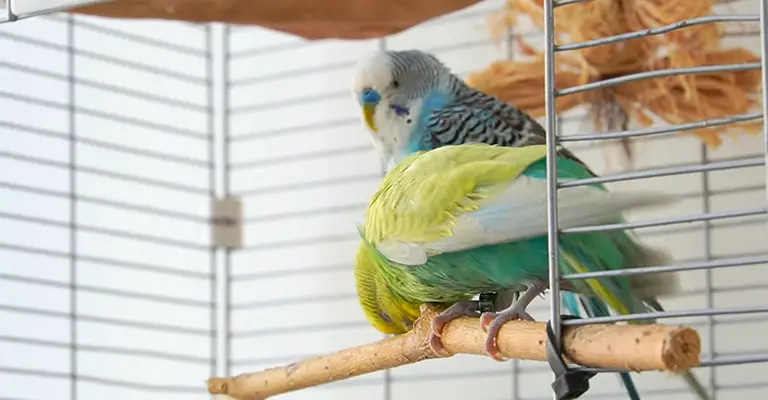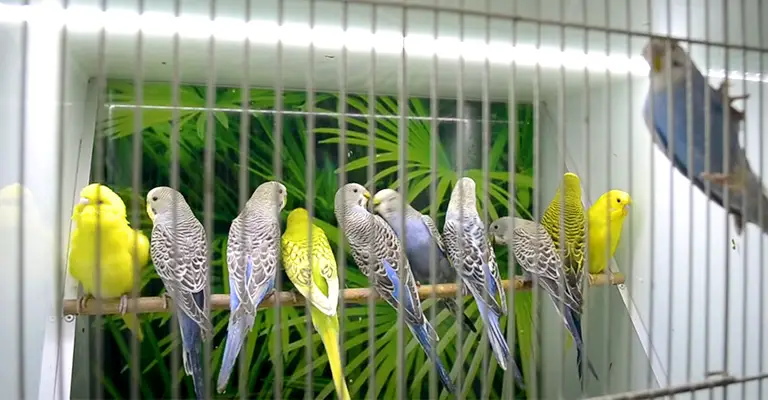The charming world of budgerigars, or budgies, is a realm where vibrant feathers and lively chirps often convey more than meets the eye.
As social and intelligent creatures, budgies have their own unique ways of communicating and forming connections with one another.
The question of how budgies show affection to each other unveils a captivating dimension of their behaviour.
From tender grooming rituals and mutual preening to playful interactions and subtle body language, these feathered companions have evolved intricate methods to express their bonds.
This exploration delves into how do budgies show affection to each other and behaviours that underscore the affectionate connections forged within budgie flocks.

How Do Budgies Show Affection to Each Other?
Budgies are social and friendly birds that show affection to each other in many ways.
Here are some ways that budgies show affection to each other:
Grooming
Grooming is one of the most common and obvious ways that budgies show affection to each other. Grooming involves using their beaks to preen, clean, or nibble on each other’s feathers, head, neck, or back.
Feeding
Feeding is another common and obvious way that budgies show affection to each other. Feeding involves using their beaks to regurgitate, share, or offer food to each other.
Cuddling
Cuddling is a more intimate and subtle way that budgies show affection to each other. Cuddling involves using their bodies to snuggle, hug, or nuzzle each other.
It helps budgies provide warmth and security to each other and also shows their love and attachment for each other.
Singing
Singing is a more vocal and expressive way that budgies show affection to each other. Singing involves using their voices to chirp, whistle, or talk to each other.
It helps budgies communicate and entertain each other and also shows their happiness and excitement for each other.
Dancing

Dancing is a more physical and playful way that budgies show affection to each other. Dancing involves using their wings, feet, or tails to flap, hop, or swing with each other.
This helps budgies exercise and have fun with each other and also shows their energy and enthusiasm for each other.
Kissing
Kissing is a more romantic and special way that budgies show affection to each other. Kissing involves using their beaks to touch, tap, or rub each other’s beaks, mouths, or tongues.
This helps budgies express their feelings and emotions for each other and also shows their passion and attraction for each other.
Mating
Mating is the most intimate and ultimate way that budgies show affection to each other. Mating involves using their cloacas to join, copulate, or fertilize with each other.
This helps budgies reproduce and create a new life with each other and also shows their commitment and devotion to each other.
Protecting
Protecting is a more defensive and courageous way for budgies to show affection to each other. Protecting involves using their beaks, claws, or wings to defend, guard, or fight for each other.
It helps budgies ensure the safety and well-being of each other and also shows their respect and admiration for each other.
Gift-giving
Gift-giving is a more creative and generous way for budgies to show affection to each other. Gift-giving involves using their beaks or feet to collect, present, or exchange items with each other.
How Do You Bond With Two Budgies?

Bonding with two budgies can be a rewarding and enjoyable experience, as you can develop a close and trusting relationship with them.
However, bonding with two budgies can also be challenging and time-consuming, as you need to balance your attention and care for both of them.
Here are some tips to help you bond with two budgies, along with some descriptions of each point:
Choose Compatible Budgies
The first step to bonding with two budgies is to choose compatible budgies that can get along well with each other and with you.
Compatible budgies are those that have similar personalities, preferences, and habits and that show positive signs such as grooming, feeding, cuddling, or singing to each other.
Provide A Spacious And Comfortable Cage
The second step to bonding with two budgies is to provide a spacious and comfortable cage that can accommodate both of them and their needs.
The cage should be large enough for them to fly, play, and rest without feeling cramped or crowded.
Provide Enough Food And Water
The third step to bond with two budgies is to provide enough food and water for both of them and make sure they have easy access to them.
You should provide a balanced and varied diet that consists of pellets, seeds, fruits, vegetables, and occasional treats.
Spend Time With Them Every Day
The fourth step to bond with two budgies is to spend time with them every day and interact with them in positive and gentle ways.
You should talk to them softly, offer them treats, teach them tricks or games, and handle them gently.
Balance Your Attention And Care For Both Of Them
The fifth step to bonding with two budgies is to balance your attention and care for both of them and avoid favouring or neglecting either of them.
You should give equal amounts of time, affection, and praise to both of them and avoid showing any signs of bias or preference.
Introduce New Things Gradually And Carefully
The sixth step to bond with two budgies is to introduce new things gradually and carefully to avoid stressing or scaring them.
You should introduce new people, animals, objects, or environments to them one at a time and let them observe and explore them at their own pace.
Respect Their Boundaries And Signals
The seventh step to bond with two budgies is to respect their boundaries and signals and avoid forcing or pushing them to do something they don’t want to do.
You should observe their body language and vocalization and look for any signs of comfort, discomfort, or aggression.
Be Patient And Consistent
The eighth step to bond with two budgies is to be patient and consistent and avoid expecting or demanding too much from them.
You should understand that bonding with two budgies takes time and effort and that each budgie has its own personality and pace.
Have Fun And Enjoy The Process
The final step to bond with two budgies is to have fun, enjoy the process, and appreciate the rewards and benefits of having a close and trusting relationship with them.
You should celebrate their achievements and milestones and share their joys and sorrows.
How Do I Make Sure That My Budgies Show Affection Or Fight With Each Other?

Determining whether your budgies are showing affection or engaging in conflict requires careful observation of their behaviours and interactions.
Here are some key observations to help you differentiate between these two behaviours:
Mutual Preening
If you notice your budgies gently preening each other’s feathers, it’s a sign of bonding and affection. They will often groom specific areas that are hard for the other birds to reach.
Beak Nuzzling
Gentle beak-to-beak contact, without aggression or territorial behaviour, can indicate companionship and closeness.
Sharing Food
Budgies that offer food to each other are displaying signs of trust and camaraderie. Sharing treats or feeding each other is a gesture of affection.
Sleeping Side by Side
If your budgies sleep close together, often touching or nestled side by side, it’s a positive indication of their bond.
Vocal Interactions
Budgies in an affectionate relationship may engage in quiet chirping or soft cooing when together. This communication reinforces their connection.
Comfortable Proximity
Affectionate budgies will spend time close to each other without signs of stress, aggression, or territorial behaviour.
Head Bobbing
Gently bobbing their heads up and down while near each other can be a sign of budgies communicating affectionately.
Mirror Play
Budgies may interact with their reflections together in a mirror, often in a playful and curious manner, which can signify a harmonious relationship.
Calmness and Relaxed Body Language
Budgies displaying affection will exhibit relaxed body postures, with open wings, a calm demeanour, and minimal signs of stress like aggressive beak flaring or feather puffing.
By consistently observing these behaviours and considering the context in which they occur, you can gain insights into whether your budgies are expressing affection or potentially engaged in conflict.
Remember that budgies, like any social animals, will have their own personalities and dynamics, so understanding their unique cues is key to fostering a harmonious environment for them.
FAQ
Budgies display affection through behaviours like mutual preening, grooming, and nibbling each other’s feathers. They also engage in synchronized movements and share food as signs of companionship.
Mutual preening involves budgies gently grooming each other’s feathers. This behaviour not only maintains feather health but also strengthens social bonds within the flock.
Yes, sharing food is a gesture of companionship and care among budgies. Offering treats to each other can be a display of affectionate bonding.
Budgies often engage in coordinated movements like swaying or hopping together. This synchronization fosters a sense of unity and belonging within the flock.
Yes, budgies use vocalizations to express their emotions and connections. Soft, melodic sounds can be a way of showing fondness and bonding between individuals within a flock.
Conclusion
In the enchanting realm of budgie interactions, the ways in which these avian companions express affection to each other serve as a testament to their social dynamics and emotional bonds.
Through grooming, preening, synchronized movements, and vocal harmonies, budgies create a tapestry of connections that reflect their intricate understanding of flock relationships.
The subtlety of their behaviours underscores the depth of their bonds, offering a glimpse into their capacity for companionship and empathy.
By observing and cherishing these tender gestures, we deepen our appreciation for the emotional richness that these vibrant birds bring to our lives, reminding us that affection is a universal language, even among our feathered friends.